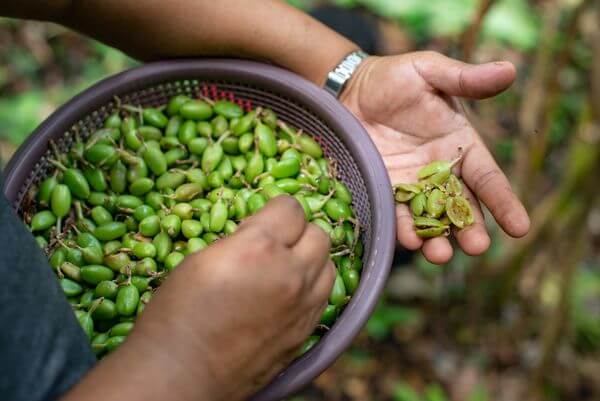Cardamom story

Cardamom, sometimes cardamon or cardamum, is a spice made from the seeds of several plants in the genera Elettaria and Amomum in the family Zingiberaceae. Both genera are native to the Indian subcontinent and Indonesia. They are recognized by their small seed pods: triangular in cross-section and spindle-shaped, with a thin, papery outer shell and small, black seeds; Elettaria pods are light green and smaller, while Amomum pods are larger and dark brown.
Species used for cardamom are native throughout tropical and subtropical Asia. The first references to cardamom are found in Sumer, and in the Ayurvedic literatures of India.
Cardamom has a strong, unique taste, with an intensely aromatic, resinous fragrance. Green cardamom is one of the most expensive spices by weight, but little is needed to impart flavour. It is best stored in the pod, as exposed or ground seeds quickly lose their flavour.
Cardamom is a common ingredient in Indian cooking. It is also often used in baking in the Nordic countries, in particular in Sweden, Norway, and Finland, where it is used in traditional treats such as the Scandinavian Yule bread Julekake, the Swedish kardemummabullar sweet bun, and Finnish sweet bread pulla. In the Middle East, green cardamom powder is used as a spice for sweet dishes, as well as traditional flavouring in coffee and tea. Cardamom is used to a wide extent in savoury dishes. In some Middle Eastern countries, coffee and cardamom are often ground in a wooden mortar, a mihbaj, and cooked together in a skillet, a mehmas, over wood or gas, to produce mixtures as much as 40% cardamom.

Cardamom production began in ancient times, and has been referred to in ancient Sanskrit texts as ela. The Babylonians and Assyrians recognized the health benefits of the spice early on, and trade in cardamom opened up along land routes and by the interlinked Persian Gulf route controlled from Dilmun as early as the third millennium BC Early Bronze Age, into western Asia and the Mediterranean world.
The ancient Greeks thought highly of cardamom, and the Greek physicians Dioscorides and Hippocrates wrote about its therapeutic properties, identifying it as a digestive aid. Due to demand in ancient Greece and Rome, the cardamom trade developed into a handsome luxury business; cardamom was one of the spices eligible for import tax in Alexandria in 126 CE. In medieval times, Venice became the principal importer of cardamom into the west, along with pepper, cloves and cinnamon, which was traded with merchants from the Levant with salt and meat products.
In the 19th century, Bombay and Madras were among the principal distributing ports of cardamom. India’s exports to foreign countries increased during the early 20th century, particularly to the United Kingdom, followed by Arabia, Aden, Germany, Turkey, Japan, Persia and Egypt. However, some 95% of cardamom produced in India is for domestic purposes, and India is itself by far the most important consuming country for cardamoms in the world. India also imports cardamom from Sri Lanka. In 1903–1904, these imports came to 122,076 kg (269,132 lb), valued at Rs. 1,98,710. In contrast, Guatemala’s local consumption is negligible, which supports the exportation of most of the cardamom that is produced. In the mid-1800s, Ceylon’s cardamom was chiefly imported by Canada. After saffron and vanilla, cardamom is currently the third most expensive spice, and is used as a spice and flavouring for food and liqueurs and in medicine.
